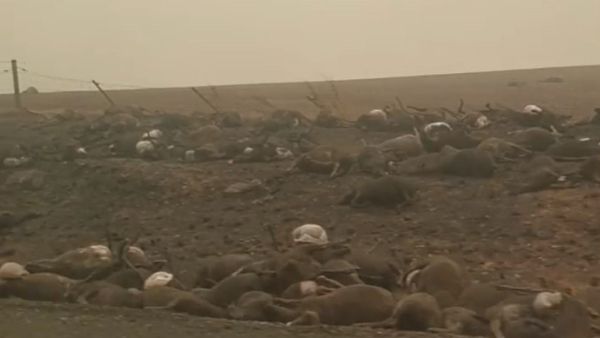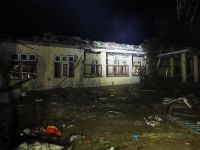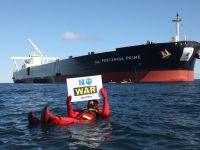The burnt bodies of hundreds of animals line the road into Batlow, one of the towns worst hit by the weekend's bushfires.
A haunting sign of the horror the area experienced on Saturday evening was caught on camera as people returned to the small rural New South Wales town on Sunday.
While smoke still fills the air around the famous apple growing community, Batlow Road - the main road in and out of the town - is lined on both sides with blackened bodies of sheep, koalas and kangaroos.
'Absolutely gut wrenching driving into Batlow this morning, never seen anything like it,' ABC cameraman Matt Roberts posted on Twitter.
'Sorry to have to share these images... it's completely heartbreaking. Worst thing I've seen. Story must be told.'
Just metres away from the roads lined with marsupials, paddocks are filled with dead sheep.
A video uploaded by the Batlow Hotel shows sheep carcasses piled up, where hours earlier they had attempted to break down fences to flee for their lives.
Authorities fear dozens of homes could have been lost on the outskirts of town, where 47-year-old David Harrison died defending his friend's home.
Mr Harrison died of a heart attack after returning to a car to refill water to help battle the blaze.
He had travelled to Batlow from his home in Goulburn to help his friend Geoff battle the blaze. He has been remembered as a hero.
Mr Harrison's brother Peter told 9News his brother would 'do anything for anyone'.
'He didn't want to leave Geoff on his own. He was just that sort of guy. He would help anyone at the drop of a hat - he would drive hours to help you,' Mr Harrison said.
'He's a hero in our eyes.'
Mr Harrison said David and Geoff had planned to evacuate but he believes they were 'overcome with the heat, smoke, exhaustion and running around putting out spot fires everywhere.'
A report will be prepared for the Coroner.
NSW Rural Fire Service Commissioner Shane Fitzsimmons said Saturday was a trying day statewide.
'It was an awful day yesterday. It was a very difficult day,' he told reporters at RFS headquarters on Sunday morning.
'We are getting reports that the property losses, the damage and destruction, is likely to be numbering in the hundreds as a result of yesterday's fire activity and fire spread.
'We're talking a considerable number, a considerable impact.'
There were reports of properties being lost in the southern slopes, the NSW south coast and the southern highlands regions.
Thirteen bushfires burnt at an emergency level on Saturday.
'That's second only to what we saw a couple of months ago, where 17 concurrent fires were burning (at emergency level),' Mr Fitzsimmons said.
Although fire weather eased on Sunday, conditions remained 'volatile' and dynamic at a number of fire grounds, Mr Fitzsimmons added.
NSW Premier Gladys Berejiklian said as of Sunday morning there were no people missing in the fires.
'That's a huge relief. Our mission yesterday was to save life. Our mission during the night was to save human life,' she told reporters.
With more than four million hectares of land burnt across the nation, there are fears some of Australia's native species could be on the brink of extinction.
Authorities previously suggested the fires could have wiped out more than 500million animals.
In South Australia, thousands of koalas are feared dead after a wild blaze devastated Kangaroo Island.
Burning more than 100,000 hectares of bush, the out-of-control fire could have long lasting effects on the island's population of 50,000 marsupials.
One of the only populations in Australia not to have been infected by chlamydia.
Authorities have urged locals not to take injured koalas to the mainland for treatment as they could contract the disease.
'We've received reports that some koalas from Kangaroo Island have been taken to Adelaide by people who want to get help for them,' the Department of Environment bushfire recovery coordinator Brenton Grear said.
'It's understandable and heartening that people want to rescue these animals, but unfortunately it will mean that those koalas can't be returned to the island because of the risk of contamination of the population there.'
This article has been adapted from its original source.








